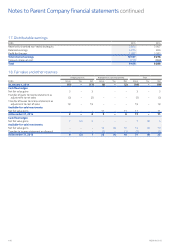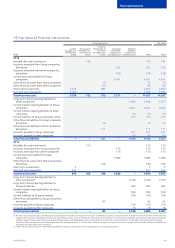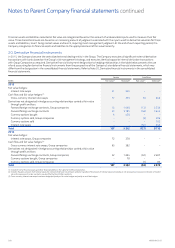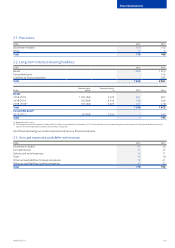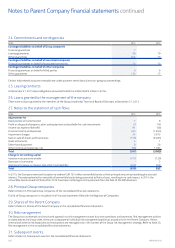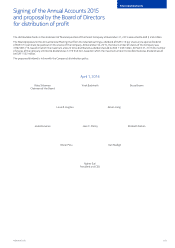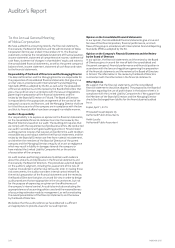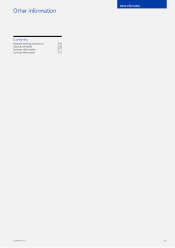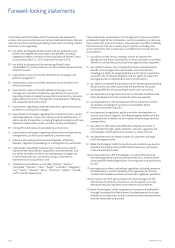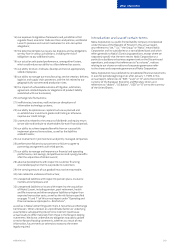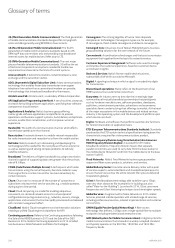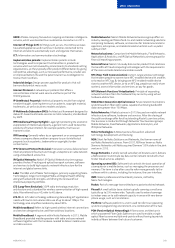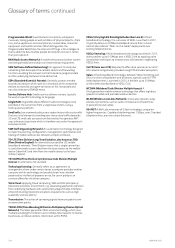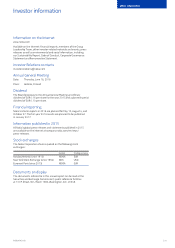Nokia 2015 Annual Report Download - page 210
Download and view the complete annual report
Please find page 210 of the 2015 Nokia annual report below. You can navigate through the pages in the report by either clicking on the pages listed below, or by using the keyword search tool below to find specific information within the annual report.208 NOKIA IN 2015
Glossary of terms
3G (Third Generation Mobile Communications): The third generation
of mobile communications standards designed for carrying both
voiceand data generally using WCDMA or close variants.
4G (Fourth Generation Mobile Communications): The fourth
generation of mobile communications standards based on LTE,
oering IP data connections only and providing true broadband
internet access for mobile devices. Refer also to LTE.
5G (Fifth Generation Mobile Communications): The next major
phaseof mobile telecommunications standards. 5G will be the set
oftechnical components and systems needed to handle new
requirements and overcome the limits of current systems.
Access network: A telecommunications network between a local
exchange and the subscriber station.
ADSL (Asymmetric Digital Subscriber Line): A data communications
technology that enables faster data transmission over copper
telephone lines rather than a conventional modem can provide;
thetechnology that introduced broadband to the masses.
Alcatel Lucent SA: Alcatel Lucent, a subsidiary of Nokia Corporation.
API (Application Programming Interface): A set of routines, protocols,
and tools for building software applications, specifying how software
components should interact.
Applications & Analytics: Nokia’s business group oering
carrier-grade software applications and platforms to provide
operations and business support systems, build, deliver, and optimize
services, enable their monetization, and to improve customer
experience.
Bandwidth: The width of a communication channel, which aects
transmission speeds over that channel.
Base station: A network element in a mobile network responsible
forradio transmission and reception to or from the mobile station.
Bell Labs: Nokia’s research arm discovering and developing the
technological shifts needed for the next phase of human existence
aswell as exploring and solving complex problems to radically
redenenetworks.
Broadband: The delivery of higher bandwidth by using transmission
channels capable of supporting data rates greater than the primary
rate of 9.6 Kbps.
CDMA (Code Division Multiple Access): A technique in which radio
transmissions using the same frequency band are coded in a way
thata signal from a certain transmitter can be received only by
certainreceivers.
Churn: Churn rate is a measure of the number of customers or
subscribers who leave their service provider, e.g. a mobile operator,
during a given time period.
Cloud: Cloud computing is a model for enabling ubiquitous,
convenient, on-demand network access to a shared pool of
congurable computing resources (e.g., networks, servers, storage,
applications and services) that can be rapidly provisioned and released
with minimal management eort.
CloudBand: Nokia’s Cloud management and orchestration solutions
enabling a unied Cloud engine and platform for NFV.
Continuing operations: Refers to the Continuing operations following
the Sale of the HERE Business in 2015 and the Sale of the D&S
Business in 2014. Nokia’s Continuing operations in 2015 included
twobusinesses: Nokia Networks and Nokia Technologies.
Convergence: The coming together of two or more disparate
disciplines or technologies. Convergence types are, for example,
IPconvergence, xed-mobile convergence and device convergence.
Converged Core: A business line of Nokia’s Mobile Networks business
group providing solutions for the core network of the future.
Core network: A combination of exchanges and the basic transmission
equipment that together form the basis for network services.
Customer Experience Management: Software suite used to manage
and improve the customer experience, based on customer, device
andnetwork insights.
Devices & Services: Nokia’s former mobile device business,
substantially all of which was sold to Microsoft.
Digital: A signaling technique in which a signal is encoded into digits
fortransmission.
Discontinued operations: Mainly refers to the divestment of our
HEREbusiness to an automotive consortium.
Ecosystem: An industry term to describe the increasingly large
communities of mutually benecial partnerships that participants
such as hardware manufacturers, software providers, developers,
publishers, entertainment providers, advertisers and ecommerce
specialists form in order to bring their oerings to market. At the heart
of the major ecosystems in the mobile devices and related services
industry is the operating system and the development platform upon
which services are built.
Engine: Hardware and software that perform essential core functions
for telecommunication or application tasks
ETSI (European Telecommunications Standards Institute): Standards
produced by the ETSI contain technical specications laying down the
characteristics required for a telecommunications product.
FD-LTE (Frequency Division Long-Term Evolution) also known as
FDD (Frequency Division Duplex): A standard for LTE mobile
broadband networks. Frequency Division means that separate,
parallelconnections are used to carry data from the base station to
the mobile device (‘downlink’) and from the mobile device to the base
station (‘uplink’).
Fixed Networks: Nokia’s Fixed Networks business group provides
copper and ber access products, solutions, and services.
Global Delivery Center: A remote service delivery center with a pool
ofservices experts, automated tools and standardized processes to
ensure that services across the entire network life cycle are delivered
to operators globally.
G.fast: A xed broadband technology able to deliver up to 1Gbps
oververy short distances (for example for in-building use, also
called“Fiber-to-the-Building”). Launched in 2014, G.fast uses more
frequencies and G.fast Vectoring techniques to achieve higher speeds.
Global Services: A segment within Nokia Networks in 2015. Global
Services provided mobile operators with a broad range of services,
including professional services, network implementation and customer
care services.
GPON (Gigabit Passive Optical Networking): A ber access
technology that delivers 2.5Gbps over a single optical ber to multiple
end points including residential and enterprise sites.
GSM (Global System for Mobile Communications): A digital system for
mobile communications that is based on a widely-accepted standard
and typically operates in the 900 MHz, 1800 MHz and 1900 MHz
frequency bands.


